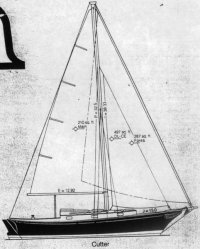sag stories
Ted,
For a 38 or similar (which means similar rig configuration and similar structural qualities), I think anything more than about 10" should be corrected to some degree. In anything up to about 5 knots TWS, you want as much sag as you can get without the HS moving around too much each time you hit a wave. Start in these conditions with no backstay tension, trim in and go sailing. Depending on the final cut length of the BS, you might be fine, or you might see the HS swinging around loosely. If so, add just enough BS tension to settle the motion down, yet leave as much sag as you can to get this effect.
From 8-12 KTWS, I would like to see 6-8" of sag-just guessing, but I would guess about 1000 pounds at about 10 KTWS will get you in the 6-7" range.
Beyond 12 kts TWS, you won't be able to get it bone straight (and you never really want that anyway), and keep adding tension so you keep the sag under 8-10"-and I agree-3000lbs should be about all you want to put on the BS adjuster, and 2500 is enough most of the time. If you have the BS adjuster loaded up and still have a lot of sag, you may need to take up a bit on the HS and/or BS using the turnbuckle with the adjuster released.
ALL genoas are designed with the assumption that there will be some sag-that is why a bone straight HS is not fast, and Note: all of these sag estimates assume a genoa with a typical shape and entry. If the genoa has some problems, like too little luff curve, you will need more sag to get it to work well than you would with a "normal" sail. Conversely, if the genoa has too much luff curve, you may be a tighter than normal HS to get the right shape.
Having said all this, the method I like best is what I described before: On the bigger boats with a wheel, trim in and sail close hauled. Steering from the high side (you ALWAYS do that, correct?

), and looking at the telltales. Look at the headstay. In over 12 KTWS, ideally you want to have the majority of the length of the HS in sight, and maybe only upper 10-15% has sagged off behind the mast and out of your line of sight. In 5-10Kts, I would want to see maybe about 80%-allowing a bit more the HS to sag behind the mast.
These are all rough estimates-in flat water you can get away with a slightly straighter HS, and in rough water you want a bit more sag. The age and quality of the sail will make a difference, and finally-don't forget the impact on the mainsail shape- too much BS and the main could becme too flat, and vice versa.You can use these numbers to get in the ballpark, and then "season to taste". Remember that sag is measured by standing at the bow and sighting up along the HS, and lining it up with the mast. The sag is the distance the middle of the HS has "sagged" away from being in line with the front of the mast.
Loren-Spot on as usual-another way to know if you are bending the boat is that you will notice the rudder binding in the shaft. It is acceptable to notice a small amount of binding when at the extreme max amount of loading, but this points out why it is so important to unload the boat when you are done for the day!!! We sometimes refer to the BS adjuster as a poor man's autopilot-since the rudder will barely move (on some boats) when the BS is loaded up. The E-boats are pretty strong, though, and you won't see too much "banana effect" on them.
Bob-When at the slip, ease the backstay mostly off-but leave just a bit on so the rig does not jump around in powerboat wakes, storms, etc. When sailing downwind ease it ALL the way off to get the mast head as far fwd as possible. In fact, take the genny halyard down to the tack fitting and grind it snug and take most of the slack out of the BS-shoving the masthead as far forward as possible-this will reduce weather helm (and hence rudder drag), and get the top of the mainsail a bit higer up and into cleaner, stronger air.
Also Jib/Genoa reaching in big air is another great time to get the mast forward, but it is harder, because if you ease the backstay your wll end up with a deep main, which you don't want....but in theory.....
I need some coffee
S



